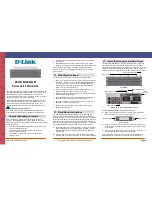
Chapter 6: Advanced Chassis Setup
6-3
System Fan Failure
Fan speed is controlled by system temperature via a BIOS setting. If a fan fails, the
remaining fans will ramp up to full speed. Replace any failed fan at your earliest
convenience with the same type and model (the system can continue to run with a
failed fan). Failed fans can be identifi ed through the BIOS. (See the fan numbering
in Figure 6-3. These numbers are also imprinted on the fl oor of the chassis.)
Replacing a System Fan (Figure 6-2)
If the BIOS is not being utilized to determine which fan has failed, open the
1.
top cover of the chassis while the system is running to locate the position of
the failed fan. Never run the server for an extended period of time with the
top cover open.
Turn off the power to the system and unplug the AC power cord.
2.
Remove the failed fan's wiring from the serverboard.
3.
Remove the four pins securing the fan to the fan tray.
4.
Lift the failed fan from the fan tray and out of the chassis.
5.
Place the new fan into the vacant space in the fan tray, while making sure the
6.
arrows on the top of the fan (indicating air direction) point in the same direc-
tion as the arrows on the other fans in the same fan tray.
Reconnect the fan wires to the exact same chassis fan headers as the previ-
7.
ous fan.
Reconnect the AC power cord, power up the system and check that the fan is
8.
working properly before replacing the chassis cover.
Figure 6-2. Removing a Fan from the Fan Tray
Содержание SuperServer 1026GT-TF
Страница 5: ...v Preface Notes...
Страница 30: ...3 4 SUPERSERVER 1026GT TF Series User s Manual Notes...
Страница 60: ...5 26 SUPERSERVER 1026GT TF Series User s Manual Notes...
Страница 98: ...7 30 SUPERSERVER 1026GT TF Series User s Manual Notes...
Страница 100: ...A 2 SUPERSERVER 1026GT TF Series User s Manual Notes...
Страница 104: ...B 4 SUPERSERVER 1026GT TF Series User s Manual Notes...
















































